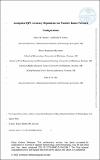| dc.contributor.author | Kurdzo, James M. | |
| dc.contributor.author | Joback, Emily F. | |
| dc.contributor.author | Kirstetter, Pierre-Emmanuel | |
| dc.contributor.author | Cho, John Y | |
| dc.date.accessioned | 2020-10-23T21:25:54Z | |
| dc.date.available | 2020-10-23T21:25:54Z | |
| dc.date.issued | 2020-08 | |
| dc.identifier.issn | 1558-8424 | |
| dc.identifier.issn | 1558-8432 | |
| dc.identifier.uri | https://hdl.handle.net/1721.1/128197 | |
| dc.description.abstract | The relatively low density of weather radar networks can lead to low-altitude coverage gaps. As existing networks are evaluated for gap-fillers and new networks are designed, the benefits of low-altitude coverage must be assessed quantitatively. This study takes a regression approach to modeling quantitative precipitation estimation (QPE) differences based on network density, antenna aperture, and polarimetric bias. Thousands of cases from the warm-season months of May–August 2015–2017 are processed using both the specific attenuation [R(A)] and reflectivity-differential reflectivity [R(Z,ZDR)] QPE methods and are compared against Automated Surface Observing System (ASOS) rain gauge data. QPE errors are quantified based on beam height, cross-radial resolution, added polarimetric bias, and observed rainfall rate. The collected data are used to construct a support vector machine regression model that is applied to the current WSR-88D network for holistic error quantification. An analysis of the effects of polarimetric bias on flash-flood rainfall rates is presented. Rainfall rates based on 2-year/1-hr return rates are used for a CONUS-wide analysis of QPE errors in extreme rainfall situations. These errors are then re-quantified using previously proposed network design scenarios with additional radars that provide enhanced estimate capabilities. Finally, a gap-filling scenario utilizing the QPE error model, flash-flood rainfall rates, population density, and potential additional WSR-88D sites is presented, exposing the highest-benefit coverage holes in augmenting the WSR-88D network (or a future network) relative to QPE performance. | en_US |
| dc.publisher | American Meteorological Society | en_US |
| dc.relation.isversionof | http://dx.doi.org/10.1175/jamc-d-19-0164.1 | en_US |
| dc.rights | Article is made available in accordance with the publisher's policy and may be subject to US copyright law. Please refer to the publisher's site for terms of use. | en_US |
| dc.source | John Y. N. Cho | en_US |
| dc.title | Geospatial QPE Accuracy Dependence on Weather Radar Network Configurations | en_US |
| dc.type | Article | en_US |
| dc.identifier.citation | Kurdzo, James M. et al. "Geospatial QPE Accuracy Dependence on Weather Radar Network Configurations." Journal of Applied Meteorology and Climatology (August 2020): 1–56 | en_US |
| dc.contributor.department | Lincoln Laboratory | en_US |
| dc.relation.journal | Journal of Applied Meteorology and Climatology | en_US |
| dc.eprint.version | Author's final manuscript | en_US |
| dc.type.uri | http://purl.org/eprint/type/JournalArticle | en_US |
| eprint.status | http://purl.org/eprint/status/PeerReviewed | en_US |
| dspace.date.submission | 2020-08-31T20:42:49Z | |
| mit.license | PUBLISHER_POLICY | |
| mit.metadata.status | Complete | |
